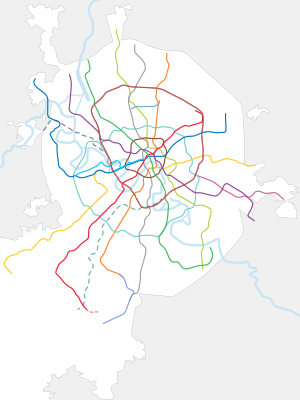
A | B | C | D | E | F | G | H | CH | I | J | K | L | M | N | O | P | Q | R | S | T | U | V | W | X | Y | Z | 0 | 1 | 2 | 3 | 4 | 5 | 6 | 7 | 8 | 9
| Moscow Metro | |||
|---|---|---|---|
 | |||
| Overview | |||
| Native name | Московский метрополитен | ||
| Owner | Government of Moscow | ||
| Area served | Moscow | ||
| Locale | Federal city of Moscow and cities of Kotelniki, Krasnogorsk, Lyubertsy, Reutov in Moscow Oblast, Russia | ||
| Transit type | Rapid transit | ||
| Number of lines | 19 (including the Moscow Monorail and the Moscow Central Circle)[1] | ||
| Number of stations | 294 | ||
| Daily ridership | (average) 7.5 million (highest, 26 Dec 2014) 9.715 million [1] | ||
| Annual ridership | 2.5 billion (2018)[1] | ||
| Chief executive | Viktor Kozlovsky | ||
| Website | mosmetro | ||
| Operation | |||
| Began operation | 15 May 1935 | ||
| Operator(s) | Moskovsky Metropoliten | ||
| Headway | Peak hours: 1.3 - 1.7 mins Off-peak: 2.5 - 10 minutes | ||
| Technical | |||
| System length | 514.5 km (319.7 mi)[1] | ||
| Track gauge | 1,520 mm (4 ft 11+27⁄32 in) | ||
| Electrification | 825 Volt DC third rail, 3 kV DC overhead line | ||
| Average speed | 39.54 km/h (24.57 mph)[1] | ||
| Top speed | 80 km/h (50 mph)[1] | ||
| |||
The Moscow Metro[a] is a metro system serving the Russian capital of Moscow as well as the neighbouring cities of Krasnogorsk, Reutov, Lyubertsy and Kotelniki in Moscow Oblast. Opened in 1935 with one 11-kilometre (6.8 mi) line and 13 stations, it was the first underground railway system in the Soviet Union.
As of 2023[update], the Moscow Metro, excluding the Moscow Central Circle, the Moscow Central Diameters and the Moscow Monorail, had 294 stations and 514.5 km (319.7 mi) of route length, excluding light rail Monorail,[1] making it the 10th-longest in the world and the longest outside East Asia. It is the third metro system in the world (after Madrid and Beijing), which has two ring lines.[2] The system is mostly underground, with the deepest section 73 metres underground at the Park Pobedy station, one of the world's deepest underground stations. It is the busiest metro system in Europe, the busiest in the world outside Asia, and is considered a tourist attraction in itself.[3]
The Moscow Metro is a world leader in the frequency of train traffic, as intervals during peak hours often do not exceed 90 seconds.[4] In February 2023, Moscow was the first in the world to reduce the intervals of metro trains to 80 seconds, but in practice trains are not likely to exceed the 90 seconds interval.[5]
Name
The full legal name of the metro has been Moscow Order of Lenin and Order of the Red Banner of Labor V.I. Lenin Metro (Московский ордена Ленина и ордена Трудового Красного Знамени метрополитен имени В.И. Ленина) since 1955. This is usually shortened to V.I. Lenin Metro (Метрополитен им. В.И. Ленина). This shorter official name appears on many stations. Although there were proposals to remove Lenin from the official name, it still stands. During the 1990s and 2000s, Lenin's name was excluded from the signage on newly built and reconstructed stations. In 2016, a Metro representative stated that Lenin's name would remain on station name plates as it aligns with the official name of the company, unchanged since the Soviet era.[6]
The first official name of the metro was L. M. Kaganovich Metro (Метрополитен им. Л.М. Кагановича) after Lazar Kaganovich.[7] (see History section). However, when the Metro was awarded the Order of Lenin, it was officially renamed Moscow Order of Lenin L. M. Kaganovich Metro (Московский ордена Ленина Метрополитен им. Л. М. Кагановича) in 1947. When the metro was renamed in 1955, the Okhotny Ryad station was renamed as "Imeni Kaganovicha" in honor of Lazar Kaganovich. In 1957, the original Okhotny Ryad name of the station was reinstated.[8]
Logo
The first line of the Moscow Metro was launched in 1935, complete with the first logo, the capital M paired with the text "МЕТРО". There is no accurate information about the author of the logo, so it is often attributed to the architects of the first stations – Samuil Kravets, Ivan Taranov and Nadezhda Bykova. At the opening in 1935, the M letter on the logo had no definite shape.[9]
In 2014, the Moscow Metro adopted a standardized logo of the network as part of a broader rebranding of the Moscow Transport.[10]
Operations
The Moscow Metro, a state-owned enterprise,[11] is 449 km (279 mi) long and consists of 15 lines and 263 stations[12] organized in a spoke-hub distribution paradigm, with the majority of rail lines running radially from the centre of Moscow to the outlying areas. The Koltsevaya Line (line 5) forms a 20-kilometre (12 mi) long circle which enables passenger travel between these diameters, and the new Moscow Central Circle (line 14) and even newer Bolshaya Koltsevaya line (line 11) form a 54-kilometre (34 mi) and 57-kilometre (35 mi) long circles respectively that serve a similar purpose on middle periphery.[13] Most stations and lines are underground, but some lines have at-grade and elevated sections; the Filyovskaya Line, Butovskaya Line and the Central Circle Line are the three lines that are at grade or mostly at grade.
The Moscow Metro uses 1,520 mm (4 ft 11+27⁄32 in) Russian gauge, like other Russian railways, and an underrunning third rail with a supply of 825 Volts DC,[citation needed] except lines 13 and 14, the former being a monorail, and the latter being directly connected to the mainlines with 3000V DC overhead lines, as is typical. The average distance between stations is 1.7 kilometres (1.1 mi); the shortest (502 metres (1,647 ft) long) section is between Delovoy Tsentr and Mezhdunarodnaya, and the longest (6.62 kilometres (4.11 mi) long) is between Krylatskoye and Strogino. Long distances between stations have the positive effect of a high cruising speed of 41.7 kilometres per hour (25.9 mph).
The Moscow Metro opens at 05:25 and closes at 01:00.[14] The exact opening time varies at different stations according to the arrival of the first train, but all stations simultaneously close their entrances at 01:00 for maintenance, and so do transfer corridors. The minimum interval between trains is 90 seconds during the morning and evening rush hours.[1]
As of 2017, the system had an average daily ridership of 6.99 million passengers. Peak daily ridership of 9.71 million was recorded on 26 December 2014.[1]
Free Wi-Fi has been available on all lines of the Moscow Metro since 2 December 2014.[15]
Network
This section needs to be updated. (March 2023) |

Lines
Each line is identified by a name, an alphanumeric index (usually consisting of just a number, and sometimes a letter suffix), and a colour.[16] The colour assigned to each line is its colloquial identifier, except for the nondescript greens and blues assigned to the Bolshaya Koltsevaya, the Lyublinsko-Dmitrovskaya, and Butovskaya lines (lines 11, 10, and 12, respectively).[17] The upcoming station is announced by a male voice on inbound trains to the city center (on the Circle line, the clockwise trains), and by a female voice on outbound trains (anti-clockwise trains on the Circle line).[16]
The metro has a connection to the Moscow Monorail, a 4.7-kilometre (2.9 mi), six-station monorail line between Timiryazevskaya and VDNKh which opened in January 2008. Prior to the official opening, the monorail had operated in "excursion mode" since 2004.














